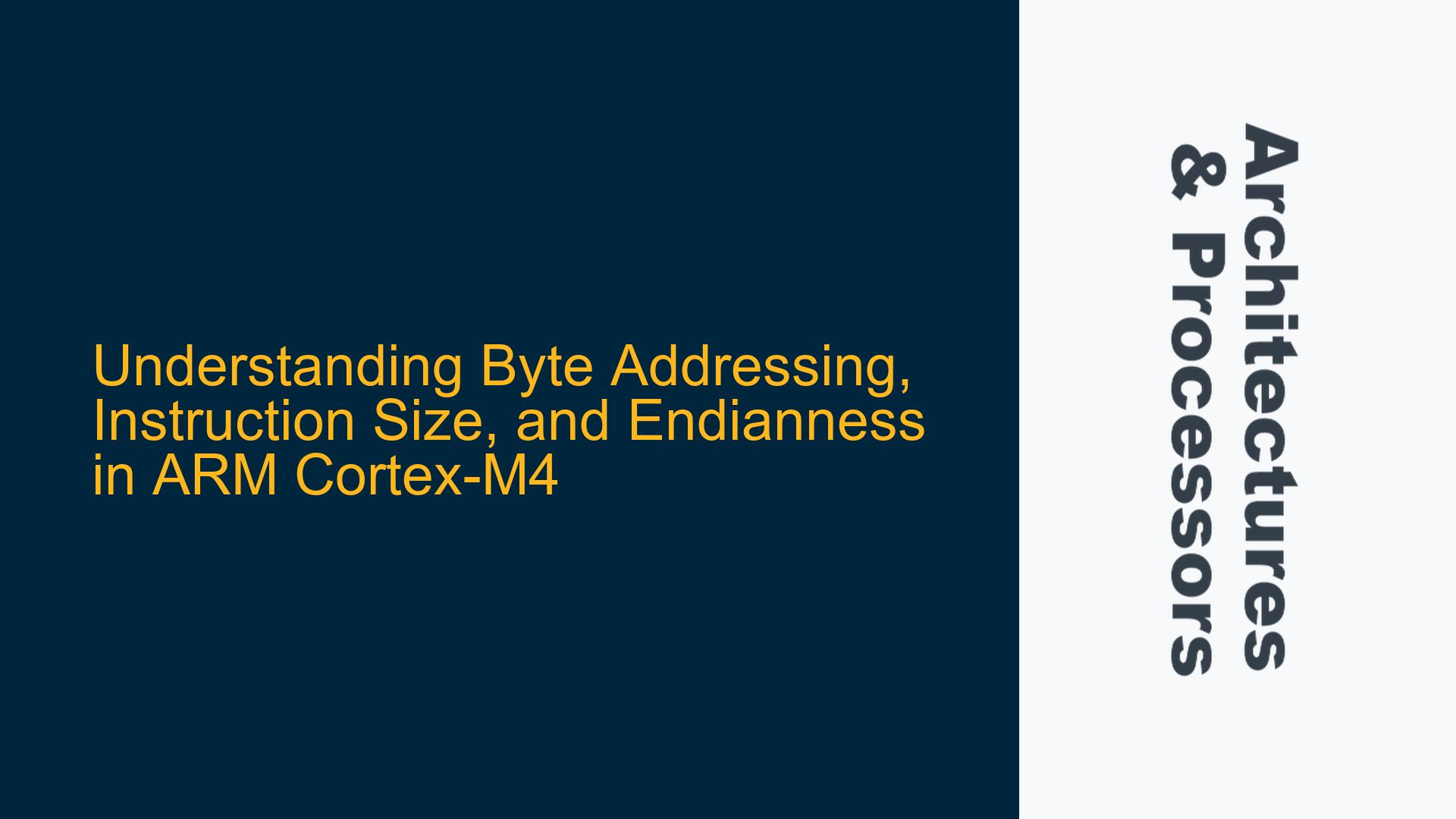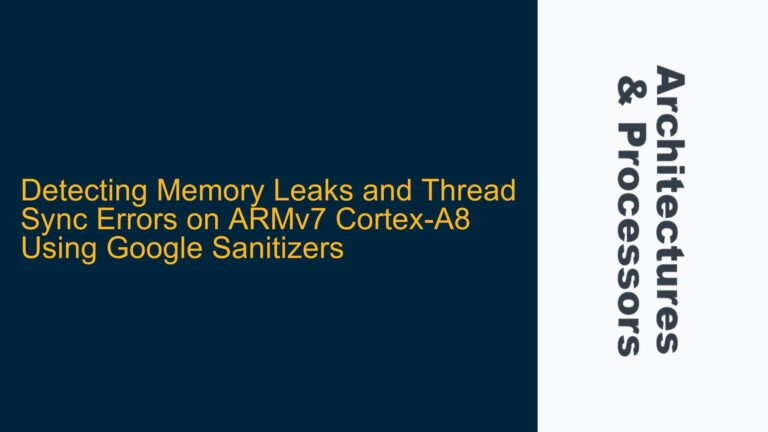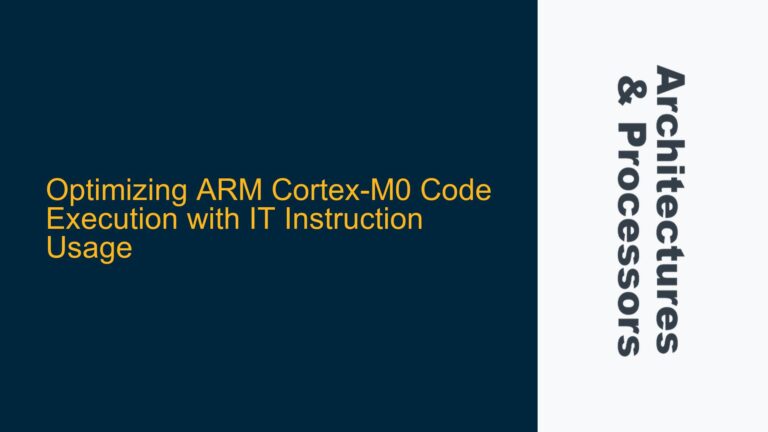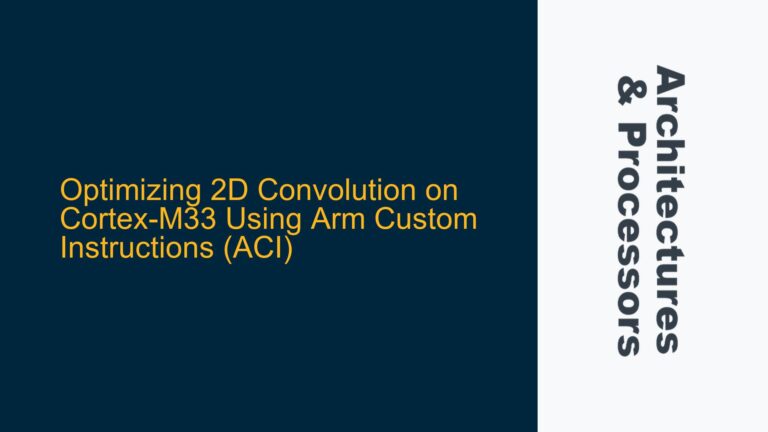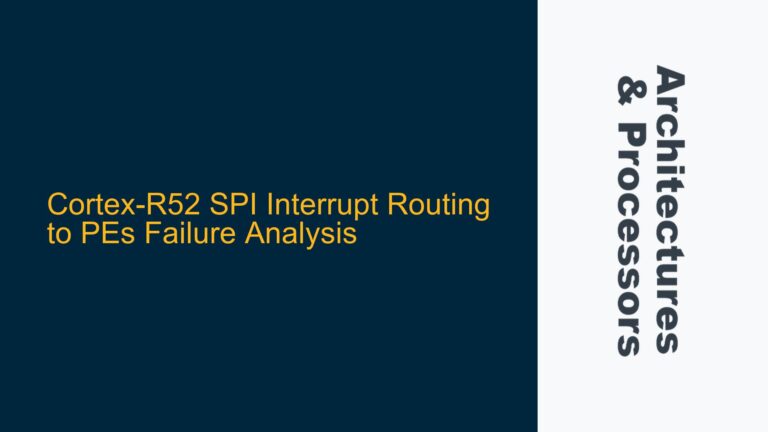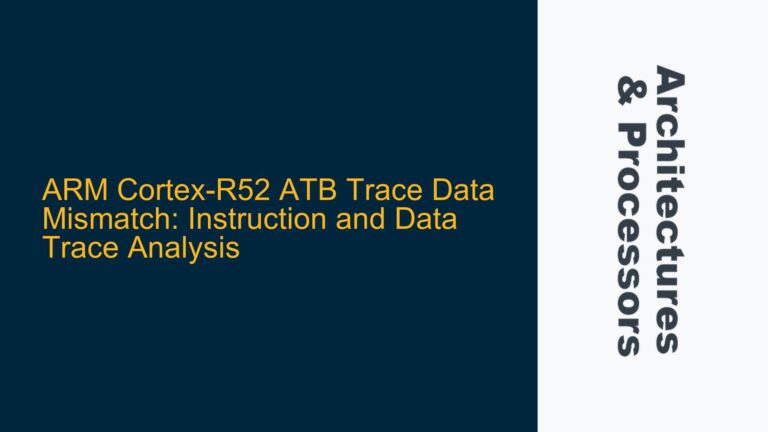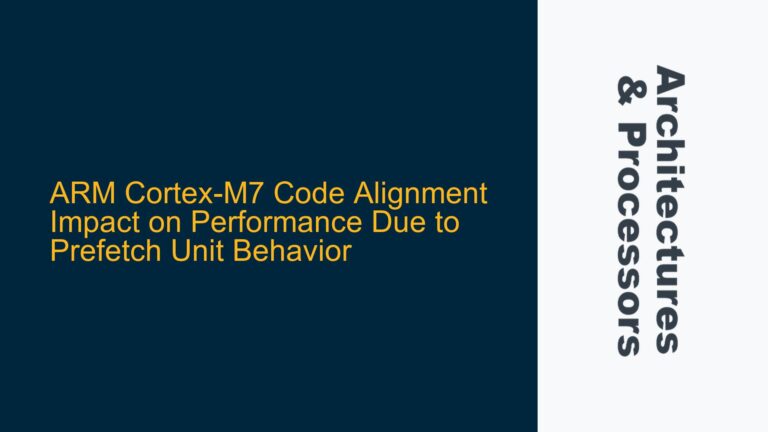ARM Cortex-M4 Byte Addressing and Instruction Size Confusion
The ARM Cortex-M4 processor, like many modern microcontrollers, employs a byte-addressable memory system. This means that each byte in memory has a unique address, and the processor can access individual bytes, half-words (16 bits), or words (32 bits) from memory. This design choice is crucial for supporting various data types and efficient memory utilization. However, this byte-addressable nature can lead to confusion when dealing with instruction sizes and memory allocation, especially for those transitioning from architectures where memory is word-addressable.
In the Cortex-M4, instructions are primarily encoded in Thumb or Thumb-2 formats. Thumb instructions are 16 bits wide, while Thumb-2 instructions can be either 16 or 32 bits wide. This variable instruction size is a key feature of the ARM architecture, allowing for a compact code size while still providing the flexibility of 32-bit instructions when needed. When disassembling code, you may notice that each instruction occupies multiple byte addresses. For example, a 32-bit Thumb-2 instruction will span four byte addresses, while a 16-bit Thumb instruction will span two byte addresses. This is a direct consequence of the byte-addressable memory system.
The Cortex-M4’s memory system is designed to handle these variable-sized instructions efficiently. When fetching instructions, the processor reads memory in chunks that align with the instruction size. For instance, a 32-bit instruction fetch will read four consecutive bytes from memory, starting at an address that is aligned to a 4-byte boundary. This alignment ensures that the processor can fetch and decode instructions correctly, regardless of their size.
Endianness Configuration and Implications in ARM Cortex-M4
Endianness refers to the order in which bytes are arranged within a larger data word in memory. In a little-endian system, the least significant byte (LSB) is stored at the lowest memory address, while the most significant byte (MSB) is stored at the highest memory address. In a big-endian system, the order is reversed, with the MSB stored at the lowest address and the LSB at the highest address. The ARM Cortex-M4 processor supports both little-endian and big-endian configurations, but the choice of endianness is typically fixed at the hardware level and cannot be changed dynamically during runtime.
The endianness configuration of the Cortex-M4 is determined during the chip design phase and is usually set to little-endian by default. This is because little-endian is the more common configuration in modern embedded systems, and it aligns with the byte-ordering conventions used in many communication protocols and file formats. However, some applications may require big-endian ordering, particularly when interfacing with legacy systems or specific hardware peripherals that expect data in big-endian format.
In the Cortex-M4, the endianness configuration affects how data is stored and retrieved from memory. For example, when a 32-bit word is stored in memory, the byte ordering will differ between little-endian and big-endian systems. In a little-endian system, the byte at the lowest address will contain the LSB, while in a big-endian system, the byte at the lowest address will contain the MSB. This difference must be taken into account when writing software that interacts with memory-mapped peripherals or when exchanging data between systems with different endianness configurations.
The ARMv7-M Architecture Reference Manual provides detailed information on how endianness is controlled in the Cortex-M4. Specifically, Section A3.3 "Control of endianness in ARMv7-M" describes the mechanisms by which endianness is determined and how it affects memory access. It is important to note that changing the endianness of a Cortex-M4 processor typically requires a hardware reset or, in some cases, a complete redesign of the chip. Therefore, it is crucial to determine the appropriate endianness configuration during the initial design phase of the system.
Addressing Endianness and Instruction Fetching in Cortex-M4 Firmware
When developing firmware for the ARM Cortex-M4, it is essential to understand how endianness and instruction fetching interact with the byte-addressable memory system. One common issue that arises is the misalignment of data or instructions due to incorrect assumptions about memory addressing. For example, if a developer assumes that a 32-bit instruction will be stored at a single memory address, they may encounter errors when the instruction spans multiple byte addresses.
To avoid such issues, it is important to use the appropriate memory access instructions and alignment directives provided by the ARM architecture. For instance, when accessing 32-bit data, the LDR and STR instructions should be used to ensure that the data is correctly aligned and accessed in the proper byte order. Similarly, when writing assembly code, it is crucial to account for the variable size of Thumb and Thumb-2 instructions and ensure that they are correctly aligned in memory.
In addition to proper alignment, developers must also consider the endianness of the system when working with multi-byte data types. For example, when reading a 32-bit value from memory, the byte order must be correctly interpreted based on the endianness configuration of the processor. This can be particularly important when interfacing with external devices or when transferring data between systems with different endianness configurations.
To address these challenges, the ARM Cortex-M4 provides several mechanisms for managing memory access and ensuring data consistency. One such mechanism is the use of memory barriers, which ensure that memory operations are performed in the correct order and that the processor’s view of memory is consistent with the actual state of memory. Memory barriers are particularly important in multi-threaded or interrupt-driven systems, where the order of memory accesses can affect the correctness of the program.
Another important consideration is the use of the Cortex-M4’s memory protection unit (MPU), which can be used to enforce memory access permissions and prevent unauthorized access to critical memory regions. The MPU can be configured to protect specific regions of memory, such as the stack or peripheral registers, and can help prevent common programming errors that lead to memory corruption or security vulnerabilities.
In summary, understanding the byte-addressable nature of the ARM Cortex-M4’s memory system, the variable size of Thumb and Thumb-2 instructions, and the implications of endianness is crucial for developing reliable and efficient firmware. By using the appropriate memory access instructions, alignment directives, and memory management mechanisms, developers can avoid common pitfalls and ensure that their code runs correctly on the Cortex-M4 processor.
Detailed Analysis of Memory Access Patterns and Instruction Fetching
To further understand the intricacies of memory access and instruction fetching in the ARM Cortex-M4, it is helpful to delve into the specific patterns and behaviors that the processor exhibits. The Cortex-M4’s memory system is designed to optimize both data access and instruction fetching, but this optimization requires careful consideration of memory alignment, instruction size, and endianness.
When the Cortex-M4 fetches instructions from memory, it does so in chunks that align with the size of the instruction. For example, when fetching a 32-bit Thumb-2 instruction, the processor will read four consecutive bytes from memory, starting at an address that is aligned to a 4-byte boundary. This alignment ensures that the instruction can be correctly decoded and executed by the processor. If the instruction is not properly aligned, the processor may generate an alignment fault, which can lead to unexpected behavior or a system crash.
Similarly, when accessing data, the Cortex-M4 requires that multi-byte data types be properly aligned in memory. For example, a 32-bit data value should be stored at an address that is aligned to a 4-byte boundary. If the data is not properly aligned, the processor may generate an alignment fault, or it may perform multiple memory accesses to retrieve the data, which can degrade performance.
The endianness of the system also plays a critical role in how data is accessed and interpreted. In a little-endian system, the byte at the lowest address is the least significant byte (LSB) of the data word, while in a big-endian system, the byte at the lowest address is the most significant byte (MSB). This difference affects how data is stored and retrieved from memory, and it must be taken into account when writing software that interacts with memory-mapped peripherals or when exchanging data between systems with different endianness configurations.
To illustrate these concepts, consider the following example: Suppose you have a 32-bit data value 0x12345678 that needs to be stored in memory. In a little-endian system, this value would be stored as follows:
| Memory Address | Byte Value |
|---|---|
| 0x0000 | 0x78 |
| 0x0001 | 0x56 |
| 0x0002 | 0x34 |
| 0x0003 | 0x12 |
In contrast, in a big-endian system, the same value would be stored as:
| Memory Address | Byte Value |
|---|---|
| 0x0000 | 0x12 |
| 0x0001 | 0x34 |
| 0x0002 | 0x56 |
| 0x0003 | 0x78 |
As you can see, the byte order is reversed between little-endian and big-endian systems. This difference must be accounted for when writing software that interacts with memory-mapped peripherals or when exchanging data between systems with different endianness configurations.
Practical Considerations for Firmware Development on Cortex-M4
When developing firmware for the ARM Cortex-M4, there are several practical considerations that developers must keep in mind to ensure that their code is efficient, reliable, and compatible with the processor’s memory system. These considerations include proper memory alignment, endianness awareness, and the use of memory barriers and the memory protection unit (MPU).
Memory Alignment
Proper memory alignment is critical for ensuring that data and instructions are accessed correctly by the Cortex-M4 processor. Misaligned memory accesses can lead to alignment faults, which can cause the program to crash or behave unexpectedly. To avoid alignment faults, developers should ensure that multi-byte data types are stored at addresses that are aligned to their size. For example, 32-bit data should be stored at addresses that are aligned to 4-byte boundaries, while 16-bit data should be stored at addresses that are aligned to 2-byte boundaries.
In addition to data alignment, developers must also ensure that instructions are properly aligned in memory. Thumb instructions are 16 bits wide and should be stored at 2-byte aligned addresses, while Thumb-2 instructions can be either 16 or 32 bits wide and should be stored at addresses that are aligned to their size. Proper instruction alignment ensures that the processor can fetch and decode instructions correctly, which is essential for the correct execution of the program.
Endianness Awareness
Endianness awareness is another important consideration when developing firmware for the Cortex-M4. As discussed earlier, the endianness of the system affects how data is stored and retrieved from memory. Developers must be aware of the endianness configuration of their system and ensure that their code correctly interprets multi-byte data types based on the system’s endianness.
In some cases, it may be necessary to convert data between little-endian and big-endian formats. For example, when exchanging data between systems with different endianness configurations, developers may need to perform byte-swapping operations to ensure that the data is correctly interpreted. The Cortex-M4 provides several instructions that can be used to perform byte-swapping operations, such as the REV, REV16, and REVSH instructions, which reverse the byte order of 32-bit, 16-bit, and 16-bit signed data, respectively.
Memory Barriers and the Memory Protection Unit (MPU)
Memory barriers are another important tool for ensuring the correct operation of firmware on the Cortex-M4. Memory barriers are used to enforce the order of memory operations and ensure that the processor’s view of memory is consistent with the actual state of memory. Memory barriers are particularly important in multi-threaded or interrupt-driven systems, where the order of memory accesses can affect the correctness of the program.
The Cortex-M4 provides several memory barrier instructions, such as DMB (Data Memory Barrier), DSB (Data Synchronization Barrier), and ISB (Instruction Synchronization Barrier). These instructions can be used to ensure that memory operations are performed in the correct order and that the processor’s view of memory is consistent with the actual state of memory.
The memory protection unit (MPU) is another important feature of the Cortex-M4 that can be used to enforce memory access permissions and prevent unauthorized access to critical memory regions. The MPU can be configured to protect specific regions of memory, such as the stack or peripheral registers, and can help prevent common programming errors that lead to memory corruption or security vulnerabilities.
Conclusion
The ARM Cortex-M4 processor’s byte-addressable memory system, variable instruction size, and endianness configuration present both opportunities and challenges for firmware developers. By understanding these features and their implications, developers can write efficient, reliable, and compatible firmware that takes full advantage of the Cortex-M4’s capabilities.
Proper memory alignment, endianness awareness, and the use of memory barriers and the memory protection unit (MPU) are essential for ensuring the correct operation of firmware on the Cortex-M4. By following best practices and using the tools and features provided by the Cortex-M4, developers can avoid common pitfalls and create robust and efficient embedded systems.
